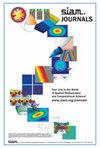基于Nesterov-Kaczmarz方法的河外考古中恒星人口运动分布重建
IF 2.3
3区 数学
Q3 COMPUTER SCIENCE, ARTIFICIAL INTELLIGENCE
引用次数: 2
摘要
本文考虑从光学积分场单位测量中重建星系恒星群-运动分布函数的问题。这些量通过一个高维积分方程联系起来。为了解决这一问题,我们提出了一种投影Nesterov-Kaczmarz重建方法,该方法有效地利用了问题的结构,并结合了平滑性和非负性约束等物理先验信息。为了测试我们的重建方法的性能,我们将其应用于已知地面真值密度模拟的数据集,并通过将我们的恢复与广泛使用的pPXF软件获得的恢复进行比较来验证它。本文章由计算机程序翻译,如有差异,请以英文原文为准。
A Projected Nesterov–Kaczmarz Approach to Stellar Population-Kinematic Distribution Reconstruction in Extragalactic Archaeology
In this paper, we consider the problem of reconstructing a galaxy’s stellar population-kinematic distribution function from optical integral field unit measurements. These quantities are connected via a high-dimensional integral equation. To solve this problem, we propose a projected Nesterov–Kaczmarz reconstruction method, which efficiently leverages the problem structure and incorporates physical prior information such as smoothness and nonnegativity constraints. To test the performance of our reconstruction approach, we apply it to a dataset simulated from a known ground truth density, and validate it by comparing our recoveries to those obtained by the widely used pPXF software.
求助全文
通过发布文献求助,成功后即可免费获取论文全文。
去求助
来源期刊

SIAM Journal on Imaging Sciences
COMPUTER SCIENCE, ARTIFICIAL INTELLIGENCE-COMPUTER SCIENCE, SOFTWARE ENGINEERING
CiteScore
3.80
自引率
4.80%
发文量
58
审稿时长
>12 weeks
期刊介绍:
SIAM Journal on Imaging Sciences (SIIMS) covers all areas of imaging sciences, broadly interpreted. It includes image formation, image processing, image analysis, image interpretation and understanding, imaging-related machine learning, and inverse problems in imaging; leading to applications to diverse areas in science, medicine, engineering, and other fields. The journal’s scope is meant to be broad enough to include areas now organized under the terms image processing, image analysis, computer graphics, computer vision, visual machine learning, and visualization. Formal approaches, at the level of mathematics and/or computations, as well as state-of-the-art practical results, are expected from manuscripts published in SIIMS. SIIMS is mathematically and computationally based, and offers a unique forum to highlight the commonality of methodology, models, and algorithms among diverse application areas of imaging sciences. SIIMS provides a broad authoritative source for fundamental results in imaging sciences, with a unique combination of mathematics and applications.
SIIMS covers a broad range of areas, including but not limited to image formation, image processing, image analysis, computer graphics, computer vision, visualization, image understanding, pattern analysis, machine intelligence, remote sensing, geoscience, signal processing, medical and biomedical imaging, and seismic imaging. The fundamental mathematical theories addressing imaging problems covered by SIIMS include, but are not limited to, harmonic analysis, partial differential equations, differential geometry, numerical analysis, information theory, learning, optimization, statistics, and probability. Research papers that innovate both in the fundamentals and in the applications are especially welcome. SIIMS focuses on conceptually new ideas, methods, and fundamentals as applied to all aspects of imaging sciences.
 求助内容:
求助内容: 应助结果提醒方式:
应助结果提醒方式:


